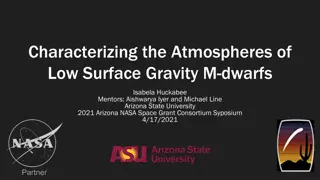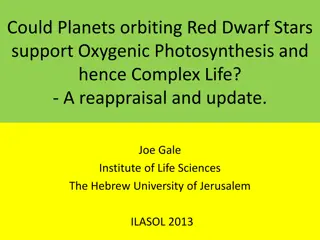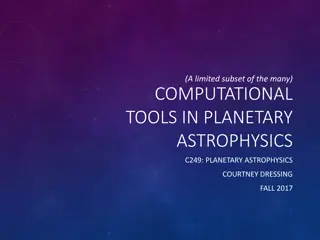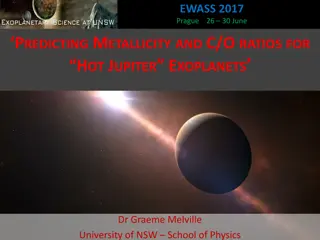Characterizing the Atmospheres of Low Surface Gravity M-dwarfs
This study focuses on characterizing the atmospheres of low surface gravity M-dwarfs, which are promising hosts for exoplanets. The research delves into why low gravity M-dwarfs appear brighter in the infrared than typical M-dwarfs, presenting an improved base model with added opacities. The finding
0 views • 8 slides
COSPAR Bureau Approves International Space Panel and Symposium Events
The COSPAR Bureau unanimously approved a list of Assembly Interdisciplinary Lectures, a public lecture on exoplanets, and an International Space Panel on Exploration. They also finalized the dates for the 43rd COSPAR Assembly in Sydney, Australia in August 2020. Additionally, various events and symp
0 views • 7 slides
The Potential for Oxygenic Photosynthesis on Planets Orbiting Red Dwarf Stars
Exploring the possibility of oxygenic photosynthesis and complex life on planets orbiting red dwarf stars, considering factors such as star life cycles, climate conditions, and radiation wavelengths. The evolution of complex life on Earth due to the essential role of oxygen and ozone is discussed in
0 views • 14 slides
Computational Tools in Planetary Astrophysics - Fall 2017
Explore a limited subset of computational tools in planetary astrophysics used for modeling planetary transits, secondary eclipses, phase curves, radial velocities, Bayesian parameter estimation, and atmospheric modeling. Tools include BATMAN, SPIDERMAN, RadVel, e.emcee, and Exo_Transmit, each servi
0 views • 7 slides
Prediction of Metallicity and C/O Ratios for Hot Jupiter Exoplanets
Dr. Graeme Melville from the University of NSW explores the modeling of atmospheres for hot Jupiter exoplanets, emphasizing the importance of temperature, PT profiles, metallicity, and the C/O ratio. Utilizing the Versatile Software for Transfer of Atmospheric Radiation (VSTAR), the research aims to
0 views • 27 slides
Impact of M Dwarf Stellar Wind on Atmospheric Escape of a Mars-like Exoplanet
The study explores how the stellar wind from M dwarf stars affects the atmospheric escape of a Mars-like planet, focusing on the potential habitability of such exoplanets. Computer simulations utilizing stellar wind parameters provide insights into ion escape and the varying conditions at different
0 views • 19 slides





